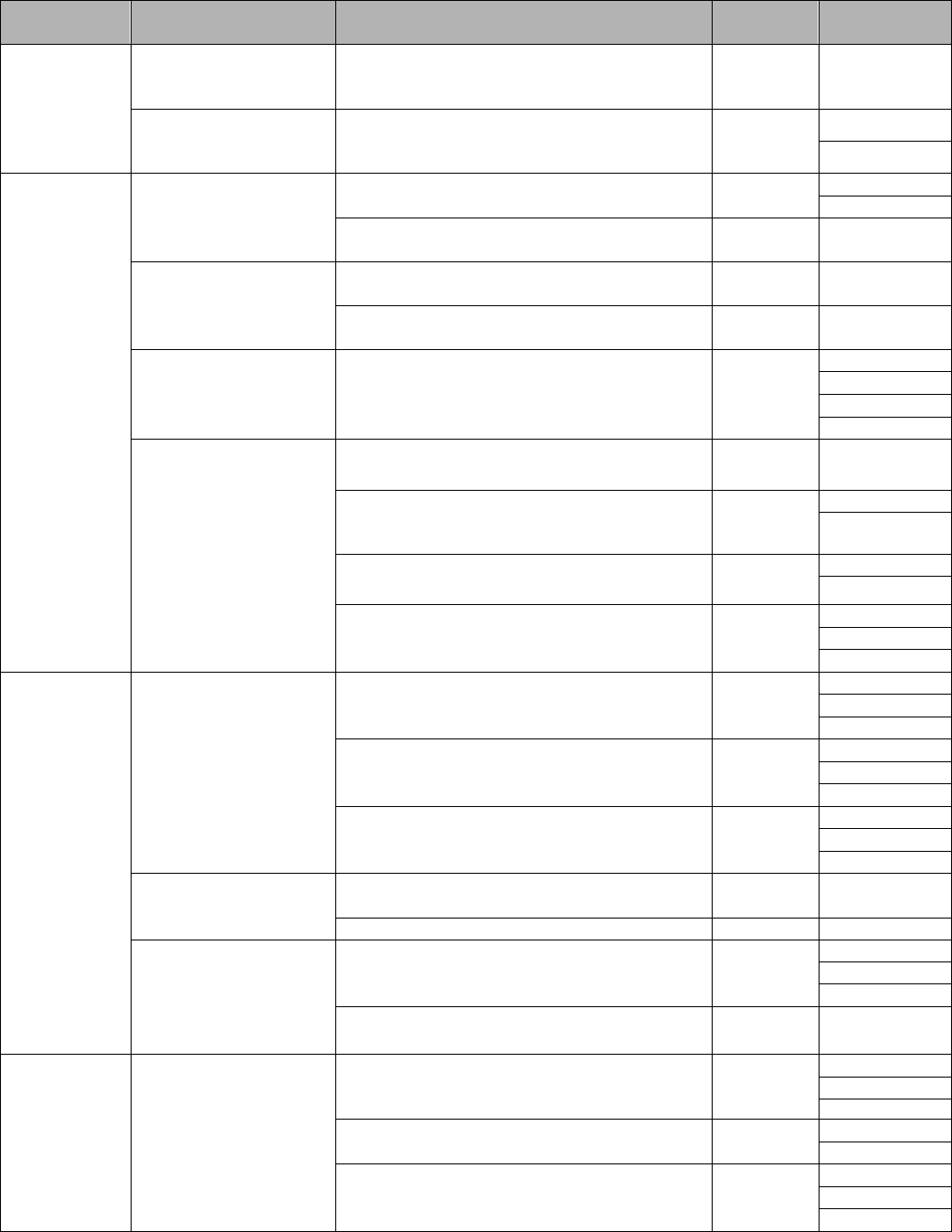
New York State
Testing Program
Educator Guide to the
Regents Examination in
Algebra I
Next Generation Mathematics Learning Standards
Updated: October 2023
THE UNIVERSITY OF THE STATE OF NEW YORK
Regents of The University
LESTER W. YOUNG, JR., Chancellor, B.S., M.S., Ed.D. ......................................
J
OSEPHINE VICTORIA FINN, Vice Chancellor B.A., J.D. .....................................
R
OGER TILLES, B.A., J.D. ....................................................................................
C
HRISTINE D. CEA, B.A., M.A., Ph.D. ..............................................................
W
ADE S. NORWOOD, B.A. .................................................................................
K
ATHLEEN M. CASHIN, B.S., M.S., Ed.D. ........................................................
J
AMES E. COTTRELL, B.S., M.D. .........................................................................
J
UDITH CHIN, B.S., M.S. in Ed. ..........................................................................
C
ATHERINE COLLINS, R.N., N.P., B.S., M.S. in Ed., Ed.D. ..............................
E
LIZABETH S. HAKANSON, A.S., B.A., M.A., C.A.S. ........................................
L
UIS O. REYES, B.A., M.A., Ph.D. ......................................................................
S
USAN W. MITTLER, B.S., M.S. ..........................................................................
F
RANCES G. WILLS, B.A., M.A., M.Ed., C.A.S., Ph.D. .....................................
A
RAMINA VEGA FERRER, B.A., M.S. in Ed., Ph.D. ..........................................
S
HINO TANIKAWA, B.A., M.S. ...........................................................................
R
OGER P. CATANIA, B.A., M.A., M.S., C.A.S., Ph.D. ......................................
A
DRIAN I. HALE, A.S., B.A. ...............................................................................
Commissioner of Education and President of The University
B
ETTY A. ROSA, B.A., M.S. in Ed., M.S. in Ed., M.Ed., Ed.D.
Senior Deputy Commissioner, Office of Education Policy
JAMES N. BALDWIN
Deputy Commissioner, P-12 Operational Support
JASON HARMON
Assistant Commissioner, Office of State Assessment
ZACHARY WARNER
Beechhurst
Monticello
Manhasset
Staten Island
Rochester
Brooklyn
New York
Little Neck
Buffalo
Syracuse
New York
Ithaca
Ossining
Bronx
Manhattan
Saranac Lake
Rochester
The State Education Department does not discriminate on the basis of race, creed, color, national origin, religion,
age, sex, military, marital status, familial status, domestic violence victim status, carrier status, disability,
genetic predisposition, sexual orientation and criminal record in its recruitment, educational programs,
services, and activities. NYSED has adopted a web accessibility policy, and publications designed for
distribution can be made available in an accessible format upon request. Inquiries regarding this policy of
nondiscrimination should be directed to the Office of Human Resources Management, Room 528 EB, Education
Building, Albany, New York 12234.

Revision Date
Revision
October 2023
p.11, the reference sheet section was revised
to provide a link to a stand-alone, printable
reference sheet with an updated Annual
Compound Interest formula
Table of Contents
Foreword............................................................................................................................................................. 1
New York State High School Mathematics Testing Program ....................................................................... 2
New York State Educators’ Involvement in Test Development.............................................................. 2
The Next Generation Mathematics Learning Standards...............................................................................3
Standards for Mathematical Practice ....................................................................................................... 3
Conceptual Categories, Domains, Clusters, Standards, and Assessment.....................................................4
Regents Examination in Algebra I Blueprint........................................................................................... 5
Algebra I Examination: Time, Format, Design, and Scoring........................................................................7
Testing Session and Time ........................................................................................................................ 7
Question Formats.....................................................................................................................................7
Algebra I Examination Design................................................................................................................. 8
Algebra I Scoring Policies ....................................................................................................................... 8
Policy Definitions ............................................................................................................................................... 9
Performance Level Descriptions.............................................................................................................. 9
Mathematics Tools for the Regents Examination in Algebra I.................................................................... 10
Reference Sheet ................................................................................................................................................ 11
Appendix A: Sample Questions for the Regents Examination in Algebra I .............................................. 12

Foreword
The information contained in this Educator Guide is designed to raise educator awareness of the
structure of the New York State Regents Examination in Algebra I measuring the New York State Next
Generation Mathematics Learning Standards.
The guide provides educators with pertinent information about the test development process, the learning
standards that the test design is set to measure, the format of the testing session, including which types of
questions will be asked, and which mathematics tools are allowed during testing. Links to additional
resources are provided to further enhance educators’ understanding of the structure of the Regents
Examination in Algebra I. Educators are encouraged to review the guide prior to the test administration to
gain familiarity with the test format. The information presented can also be used as a platform for educator
discussion on how student assessment results can guide future instruction.
The High School Regents Examination testing schedule for the June 2024 administration can be found on
the New York State Education Department’s website. Questions regarding the New York State Testing
Program and test design may be addressed to the Office of State Assessment at [email protected].
Questions regarding the New York State Learning Standards may be addressed to the Office of Standards and
Instruction at [email protected].
Algebra I Educator Guide
1

New York State High School Mathematics Testing Program
In September 2017, the Board of Regents adopted the New York State Next Generation Mathematics
Learning Standards, which were implemented at the beginning of the 2022-2023 school year. The New York
State High School Mathematics Testing Program is designed to measure student progress on the Next
Generation Mathematics Learning Standards following the implementation timeline for the Regents
Examinations as follows:
• June 2024: Algebra I
• June 2025: Geometry
• June 2026: Algebra II
New York State Educators’ Involvement in Test Development
Many steps in the test development process for the Regents Examination in Algebra I involve New York
State-certified classroom teachers. For example, teachers write and revise all test questions and scoring
rubrics. The New York State Education Department (NYSED) continues to expand the number of
opportunities for New York State educators to become involved. New York State educators provide the critical
input necessary to ensure that the tests are fair, valid, and appropriate for students through their participation
in many test-development activities.
The test development process includes the development, review, and approval of test questions, construction
of field and operational test forms, final approval of test forms prior to administration, and the development
of scoring materials. NYSED remains committed to improving the quality of the State’s assessments and the
experiences that students have taking these tests. For more information on opportunities to participate in the
test development process, please visit Test Development Participation.
Algebra I Educator Guide
2

The Next Generation Mathematics Learning Standards
The NYS Next Generation Mathematics Learning Standards define the knowledge and skills that individuals
can and do habitually demonstrate over time when exposed to high-quality instructional environments and
learning experiences. The Learning Standards, defined through the integration of the Standards for
Mathematical Content and the Standards for Mathematical Practice, collectively, are focused and cohesive
— designed to support student access to the knowledge and understanding of the mathematical concepts that
are necessary to function in a world very dependent upon the application of mathematics. Students are
expected to understand math conceptually, use procedural skills, and solve math problems rooted in the real
world, deciding for themselves which strategies, formulas, and grade-appropriate tools (e.g., calculator,
straightedge, or compass) to use.
Curriculum and instruction that support the content of the learning standards and the unique learning needs
of students are locally determined by each individual district in New York State. Teacher preference and
flexibility in planning units of study continue to play vital roles to both meet the needs of the students and
align with the expectations of the learning standards. For additional guidance with instructional planning
surrounding the Next Generation Mathematics Learning Standards, please see the Next Generation
Mathematics Learning Standards.
Standards for Mathematical Practice
The Learning Standards for each grade level (and high school course) begin with the eight Standards for
Mathematical Practice. The Standards for Mathematical Practice describe the ways in which developing
practitioners increasingly should engage with the subject matter as they grow in mathematical maturity and
expertise throughout the elementary, middle, and high school years. References to the integration of the
Standards for Mathematical Content and the Standards for Mathematical Practice are provided throughout
the Next Generation Mathematics Learning Standards.
Please note that the Algebra I overview does not include every standard/topic that should be included
in instruction. Further information about the entire scope of the learning expectations for each grade level,
as well as additional instructional considerations that include the within-grade connections, grade-level
fluencies, and connecting the Standards for Mathematical Practice to Mathematical Content can be found in
the Next Generation Mathematics Learning Standards and the associated grade-level crosswalks/snapshots.
Algebra I Educator Guide
3

Conceptual Categories, Domains, Clusters, Standards, and Assessment
The Algebra I Examination will measure the NYS Next Generation Mathematics Learning Standards. The
NYS Next Generation Mathematics Learning Standards are divided into conceptual categories, domains,
clusters, and standards.
•
Conceptual Categories are the highest organizing level in the standards and portray a coherent view
of high school mathematics.
•
Domains are larger groups of related clusters and standards. Standards from different domains may
be closely related.
•
Clusters are groups of related standards. Note that standards from different clusters may sometimes
be closely related, because mathematics is a connected subject.
•
Standards define what students should understand and be able to do. In some cases, standards are
further articulated into lettered components.
Algebra I is associated with the high school content standards within four conceptual categories:
Number & Quantity, Algebra, Functions, and Statistics & Probability. The conceptual category of
Modeling is also included in Algebra I, but is best interpreted not as a collection of isolated topics but
rather in relation to other standards. Making mathematical models is a Standard for Mathematical Practice,
and specific modeling standards appear throughout the high school standards. Modeling links classroom
mathematics and statistics to everyday life, work, and decision-making. Modeling is the process of
choosing and using appropriate mathematics and statistics to analyze empirical situations, to understand
them better, and to improve decisions.
While all questions on the Regents Examination are linked to a primary standard, some questions measure
more than one standard and one or more of the Standards for Mathematical Practice. Similarly, some
questions measure cluster-level understandings. As a result of the alignment to standards, clusters, and
Standards for Mathematical Practice, the test assesses students’ conceptual understanding, procedural
fluency, and problem-solving abilities, rather than assessing their knowledge of isolated skills and facts.
Algebra I Educator Guide
4

Regents Examination in Algebra I Blueprint
The test blueprint for the Regents Examination in Algebra I demonstrates NYSED’s commitment
to ensuring that educators are able to focus their instruction on the most critical elements of the
Algebra I course.
The following chart shows the percent of test by credit, as well as the domains included in Algebra I for each
conceptual category.
Conceptual
Category
Percent of
Test by
Credits
Domains in Algebra I
Number & Quantity
4% - 10%
The Real Number System (N-RN)
Quantities (N-Q)
Algebra
48% - 61%
Seeing Structure in Expressions (A-SSE)
Arithmetic with Polynomials and Rational Expressions (A-APR)
Creating Equations (A-CED)
Reasoning with Equations and Inequalities (A-REI)
Functions
24% - 32%
Interpreting Functions (F-IF)
Building Functions (F-BF)
Linear, Quadratic, and Exponential Models (F-LE)
Statistics &
Probability
7% - 15% Interpreting Categorical and Quantitative Data (S-ID)
The chart on page 6 of this guide illustrates the relationship between the conceptual categories, domains,
clusters, and standards that comprise Algebra I.
Algebra I Educator Guide
5

Conceptual
Category
Domain Cluster
Cluster
Code
Standard
Number &
Quantity
4% - 10%
The Real Number System
Use properties of rational and irrational numbers.
N-RN.
B
N
-RN.3(a,b
)
Q
uantities
Reason quantitatively and use units to solve
problems.
N-Q.
A
N-Q.1
N-Q.3
Algebra
48% - 61%
Seeing Structure in
Expressions
Interpret the structure of expressions. A-SSE.
A
A-SSE.1(a,b)
A-SSE.2
Write expressions in equivalent forms to reveal
their characteristics.
A-SSE.B A-SSE.3(c)
Arithmetic with
Polynomials
and Rational
Expressions
Perform arithmetic operations on polynomials.
A-APR.
A A
-APR.
1
Understand the relationship between zeros and
factors of polynomials.
A-APR.B A-APR.3
C
reating
Equations
Create equations that describe numbers or
relationships.
A-CED.A
A-CED.1
A-CED.2
A-CED.3
A-CED.4
Reasoning with Equations
and Inequalities
Understand solving equations as a process of
reasoning and explain the reasoning.
A-REI.
A
A
-REI.1
a
S
olve equations and inequalities in one
variable.
A-REI.
B
A-REI.3
A-REI.4(a,b)
Solve systems of equations.
A-REI.C
A-REI.6a
A-REI.7a
Represent and solve equations and inequalities
graphically.
A-REI.
D
A-REI.10
A-REI.11
A-REI.12
Functions
24% - 32%
Interpreting
Functions
Understand the concept of a function and use
function notation.
F-IF.
A
F-IF.1
F-IF.2
F-IF.3
Interpret functions that arise in applications in
terms of the context.
F-IF.
B
F-IF.4
F-IF.5
F-IF.6
Analyze functions using different
representations.
F-IF.C
F-IF.7(a,b)
F-IF.8(a)
F-IF.9
Building
Functions
Build a function that models a relationship
between two quantities.
F-BF.A
F
-BF.1
a
Build new functions from existing functions.
F-BF.B
F-BF.3a
Linear, Quadratic and
Exponential Models
Construct and compare linear, quadratic, and
exponential models and solve problems.
F-LE.A
F-LE.1(a,b,c)
F-LE.2
F-LE.3
Interpret expressions for functions in terms of
the situation they model.
F-LE.B
F
-LE.
5
S
tatistics &
Probability
7% - 15%
Interpreting Categorical
and Quantitative Data
Summarize, represent, and interpret data on a
single count or measurement variable.
S-ID.
A
S-ID.1
S-ID.2
S-ID.3
Summarize, represent, and interpret data on two
categorical and quantitative variables.
S-ID.B
S-ID.5
S-ID.6(a)
Interpret linear models.
S-ID.
C
S-ID.7
S-ID.8
S-ID.9
Algebra I Educator Guide
6

Algebra I Examination: Time, Format, Design, and Scoring
Testing Session and Time
The Regents Examination in Algebra I will consist of one booklet that is administered during the designated
time determined by NYSED. Students are permitted three hours to complete the Regents Examination in
Algebra I. While it is likely that most students will complete the test in less than three hours, students may
not leave the testing location prior to the Uniform Admission Deadline. This design provides ample time for
students who work at different paces.
Question Formats
The Regents Examination in Algebra I contains multiple-choice and constructed-response questions. For
multiple-choice questions, students select the correct response from four answer choices. For constructed-
response questions, students are required to clearly indicate the necessary steps, including appropriate
formula substitutions, diagrams, graphs, charts, etc. In some cases, they may be required to explain, in words,
how they arrived at their answers. Students must also have the exclusive use of a graphing calculator for the
full duration of the examination. For more information about calculator use please refer to page 10 of this
document.
Multiple-choice questions will be used to assess procedural fluency and conceptual understanding. Multiple-
choice questions measure the Standards for Mathematical Content and may incorporate Standards for
Mathematical Practices and real-world applications. Some multiple-choice questions require students to
complete multiple steps. Likewise, questions may measure more than one cluster, drawing on the
simultaneous application of multiple skills and concepts. Within answer choices, distractors
1
will be based
on plausible missteps.
Constructed-response questions will require students to show a deep understanding of mathematical
procedures, concepts, and applications. The Regents Examination in Algebra I contains 2-, 4-, and 6-credit
constructed-response questions.
The 2-credit constructed-response questions require students to complete a task and show their work. These
questions may involve multiple steps, the application of multiple mathematics skills, and real-world
applications. These questions may ask students to explain or justify their solutions and/or show their process
of problem solving.
The 4-credit and 6-credit constructed-response questions require students to show their work in completing
more extensive problems that may involve multiple tasks. Students may be asked to make sense of
mathematical and real-world problems in order to demonstrate procedural and conceptual understanding.
These questions may ask students to explain or justify their solutions and/or show their process of problem
solving.
1
A distractor is an incorrect response that may appear to be a plausible correct response to a student who has not mastered the
skill or concept being tested.
Algebra I Educator Guide
7

Algebra I Examination Design
Test
Component
Number of
Questions
Credits per
Question
Credits per
Section
Part I
24
2
48
Part II
6
2
12
Part III
4
4
16
Part IV
1
6
6
Total
35
-
82
Algebra I Scoring Policies
The general procedures to be followed in scoring Regents Examinations are provided in the publications
Directions for Administering Regents Examinations (DET 541) and the School Administrator’s Manual.
Both of these documents are available on the Department’s website. For more information see the
Information Booklet for Scoring the Regents Examination in Algebra I, the Directions for Administering
Regents Examinations, the Scoring Key and Rating Guides, and the Model Response Set for the appropriate
examination.
Algebra I Educator Guide
8

Policy Definitions
For each subject area, students perform along a continuum of the knowledge and skills necessary to meet
the demands of the Learning Standards for Mathematics. Regents Examinations are designed to classify
student performance into one of five levels based on the knowledge and skills the student has demonstrated.
Due to the need to identify student proficiency, the State tests must provide students at each performance
level opportunities to demonstrate their knowledge and skills in the Next Generation Mathematics Learning
Standards.
These performance levels are defined as:
NYS Level 5
Students performing at this level meet with distinction grade-level expectations of learning standards.
NYS Level 4
Students performing at this level fully meet grade-level expectations of learning standards (likely prepared
to succeed in the next level of coursework).
NYS Level 3
Students performing at this level minimally meet grade-level expectations of learning standards (meet the
content area requirements for a Regents diploma but may need additional support to succeed in the next level
of coursework).
NYS Level 2 (Safety Net)
Students performing at this level partially meet grade-level expectations of learning standards (sufficient
for Local Diploma purposes).
NYS Level 1
Students performing at this level demonstrate knowledge and skills below Level 2.
Performance Level Descriptions
Performance Level Descriptions exemplify the knowledge and skills that students at each performance level
demonstrate and describe the progression of learning within a subject area. The Performance Level
Descriptions play a central role in the test development process, specifically question-writing and standard-
setting. For more information about the Next Generation Mathematics Learning Standards Performance
Level Descriptions for Algebra I, please see the Algebra I webpage.
Algebra I Educator Guide
9

Mathematics Tools for the Regents Examination in Algebra I
Calculators and Straightedges (rulers)
A graphing calculator and straightedge (ruler) must be available to all students taking the Regents Examination
in Algebra I. No students may use calculators that are capable of symbol manipulation or that can communicate
with other calculators through infrared sensors, nor may students use operating manuals, instruction or formula
cards, or other information concerning the operation of calculators during the test. For more information
regarding calculators see The Guidelines for Graphing Calculator Use and the Directions for Administering
Regents Examinations.
Note: Schools are responsible for supplying the appropriate tools for use with the Regents Examination in
Algebra I.
Value of Pi
Students should use the π symbol and its corresponding value (i.e. pi key on the calculator) when applicable
on the Regents Examination in Algebra I. Unless otherwise specified, use of the approximate values of π, such
as 3.1416, 3.14, or
22
are unacceptable.
7
Mathematics Tools
The use of tools is necessary for students to meet the Standards for Mathematical Practice in the Next
Generation Mathematics Learning Standards for Mathematics. For example:
Use appropriate tools strategically
Mathematically proficient students consider the available tools when solving a mathematical problem.
Proficient students are sufficiently familiar with tools appropriate for their grade or course to make sound
decisions about when each of these tools might be helpful, recognizing both the insight to be gained and their
limitations. Mathematically proficient students at various grade levels are able to identify relevant external
mathematical resources, such as digital content located on a website, and use them to pose or solve problems.
They are able to use technological tools to explore and deepen their understanding of concepts.
Attend to precision
Mathematically proficient students try to communicate precisely to others. They try to use clear definitions in
discussion with others and in their own reasoning. They state the meaning of the symbols they choose, including
using the equal sign consistently and appropriately. They are careful about specifying units of measure and
labeling axes to clarify the correspondence with quantities in a problem. They calculate accurately and
efficiently, expressing numerical answers with a degree of precision appropriate for the problem context. In
the elementary grades, students give carefully formulated explanations to each other. By the time they reach
high school, they have learned to examine claims and make explicit use of definitions.
Algebra I Educator Guide
10
Algebra I Educator Guide
11
Reference Sheet
A detachable reference sheet will be included at the end of the Regents Examination in Algebra I test booklet.
It contains information that students are expected to apply, but not necessarily memorize. Teachers should use
this reference sheet in instruction throughout the Algebra I course t o familiarize students with its content.
This reference sheet is available at
https://www.nysed.gov/sites/default/files/programs/state-assessment/a1-next-gen-reference-sheet.pdf

Appendix A: Sample Questions for the Regents Examination in Algebra I
To aid in the implementation of the Next Generation Mathematics Learning Standards, a limited number of
sample questions are being provided to help students, parents, and educators better understand the shifts of the
NGMLS. The five questions below illustrate these shifts for Algebra I.
While educators from around the state have helped craft these sample questions, they have not undergone the
same extensive review, vetting, and field testing that occurs with actual questions used on the State exams. The
sample questions were designed to help educators think about content, NOT to show how operational exams
look exactly or to provide information about how teachers should administer the test.
1. N-RN.3a
What is the sum of 3
√
7 + 2
√
7?
(1) 5
√
7
(2) 5
2
√
7
(3) 5
√
14
(4) 5
2
√
14
2. A-REI.10
What is an equation of the line that passes through the points (2,7) and (-1,3)?
3
(1) − 2 = ( − 7)
4
4
(2) − 2 = ( − 7)
3
3
(3) − 7 = ( − 2)
4
4
(4) − 7 = ( − 2)
3
Algebra I Educator Guide
12

3. N-RN.3a
3
Rationalize:
2
√
6
4. A-REI.4b
Use the method of completing the square to determine the exact values of x for the equation
2
+ 6 − 41 = 0. Express your answer in simplest radical form.
5. A-REI.7a
Solve the following systems of equations algebraically for all values of x and y:
=
2
+ 5 − 17
− = 5
Answer Key to Algebra I Sample Items
1. Choice 1
2. Choice 4
3. Rubric
[2]
3
√
6
or an equivalent answer with no radical in the denominator, and correct work is shown.
12
[1] Appropriate work is shown, but one computational error is made.
or
[1] Appropriate work is shown, but one conceptual error is made.
or
[1]
3
√
6
, but no work is shown.
12
[0] A zero response does not contain enough relevant course-level work to receive any credit, does not
satisfy the criteria for one or more credits, or is a correct response that was obtained by an obviously
incorrect procedure.
Algebra I Educator Guide
13

4. Rubric
[4] −3 ± 5
√
2, and correct work is shown.
[3] Appropriate work is shown, but one computational or simplification error is made.
or
[3] Appropriate work is shown, but only one solution is stated.
[2] Appropriate work is shown, but two or more computational or simplification errors are made.
or
[2] Appropriate work is shown to find −3 ±
√
50, but no further correct work is shown.
or
[2] −3 ± 5
√
2, but a method other than completing the square is used.
[1] −3 ± 5
√
2, but no work is shown.
[0] A zero response does not contain enough relevant course-level work to receive any credit, does not
satisfy the criteria for one or more credits, or is a response that was obtained by an obviously incorrect
procedure.
5. Rubric
[4] = −6, = −11 and = 2, = −3 or (−6, −11) and ( 2, −3), and correct algebraic work is
shown.
[3] Appropriate work is shown, but one computational or factoring error is made.
or
[3] Appropriate work is shown to find = −6 and = 2, but no further correct work is shown.
or
[3] Appropriate work is shown to find either (−6, −11) or (2, −3), but no further correct work is
shown.
[2] Appropriate work is shown, but two or more computational or factoring errors are made.
or
[2] Appropriate work is shown to find
(
+ 6
)(
− 2
)
= 0, but no further correct work is shown.
or
[2] A correct substitution is made into the quadratic formula, but no further correct work is shown.
or
[2] = −6, = −11 and = 2, = −3, but a method other than algebraic is used.
[1] A correct quadratic equation in standard form is written, but no further correct work is shown.
or
[1] = −6, = −11 and = 2, = −3 are stated, but no work is shown.
[0] A zero response does not contain enough relevant course-level work to receive any credit, does not
satisfy the criteria for one or more credits, or is a response that was obtained by an obviously
incorrect procedure.
Algebra I Educator Guide
14
